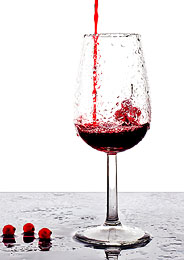 Sort of new to the wine making process, but have been very successful or lucky so far. I’ve made 4 flavors of wine in the past and have tasted well above my expect ions. But a year ago I started a cranberry wine and it has been doing great for a year now but recently it began to start to referment. Why now? It’s temp and location hasn’t changed. I’ve racked it every 3 months as it called for, very little sediment is collected on the bottom of the carboy. Why would this occur now and how or do I want to stop the process? It is stored at temperatures between 59 and 61 degrees. I have never added a sugar solution to increase the taste. I have only racked the wine every 3 months.
Sort of new to the wine making process, but have been very successful or lucky so far. I’ve made 4 flavors of wine in the past and have tasted well above my expect ions. But a year ago I started a cranberry wine and it has been doing great for a year now but recently it began to start to referment. Why now? It’s temp and location hasn’t changed. I’ve racked it every 3 months as it called for, very little sediment is collected on the bottom of the carboy. Why would this occur now and how or do I want to stop the process? It is stored at temperatures between 59 and 61 degrees. I have never added a sugar solution to increase the taste. I have only racked the wine every 3 months.
I’m not sure what other information you need in order to better help me. Any input or idea’s would be greatly appreciated. Waited a long time for this one. Thank-you Renee
Name: Renee
State: MN
The fact that you are still getting any sediment out of a wine after a years time is somewhat disturbing. It is possible to get some proteins such as tannin to drop out over time, but that normally happens at warmer temperatures, not the temperatures you have indicated. Because of this, one of the first things that comes to mind is: did the wine ever complete its fermentation originally?
If a fermentation is healthy and timely it will complete in one to two weeks. The rest of the time involved is just getting the wine to clear. If you haven’t done so already, it would be useful to take a gravity hydrometer reading to make sure that all the ordinal sugars were fermented and that you don’t have a fermentation that’s spread out over a years time. The hydrometer reading should be .996 or less on the Specific Gravity scale. If you get a Specific Gravity reading that is higher than this, then this opens the the door to the possibility that what you are seeing is, in fact, a refermentation.
As to your questions, “why now?” Even though you have your wine stored in cool temperatures, the rackings could be causing the problem, themselves. When a racking is performed more oxygen is introduced to the wine. This can do one of two things: 1) it can invigorate the wine yeast to ferment some more, 2) it can invigorate bacteria or mold to grow.
If you have been adding sulfites such as Campden tablets or Sodium Metabisulfite to the wine after each racking #2 is not very likely to be the problems, but if you have not been adding sulfites along the wine the #1 or #2 is very possible.
I hope this information helped you out. My goal is to cover the most likely scenarios. At this point what needs to happen is a gravity hydrometer reading. If the reading indicates the fermentation is complete, then add sulfites to the wine to stop whatever activity is occurring.
Happy Wine Making,
Ed Kraus
———————————————————————————————————
Ed Kraus is a 3rd generation home brewer/winemaker and has been an owner of E. C. Kraus since 1999. He has been helping individuals make better wine and beer for over 25 years.

I just started a batch of Ken Ridge Classic Cab and while adding the initial ingrediants, I forgot to add the oak granuels so I added them after the yeast and then stired the mixture. My question is, is this batch salvagable, or should I dump it and start over.
John, you do not have a problem at all. Adding the oak and stirring after adding the yeast will have no affect on the outcome of your wine. Just continue on following the directions.
one of your best news letters to date. good job folks!